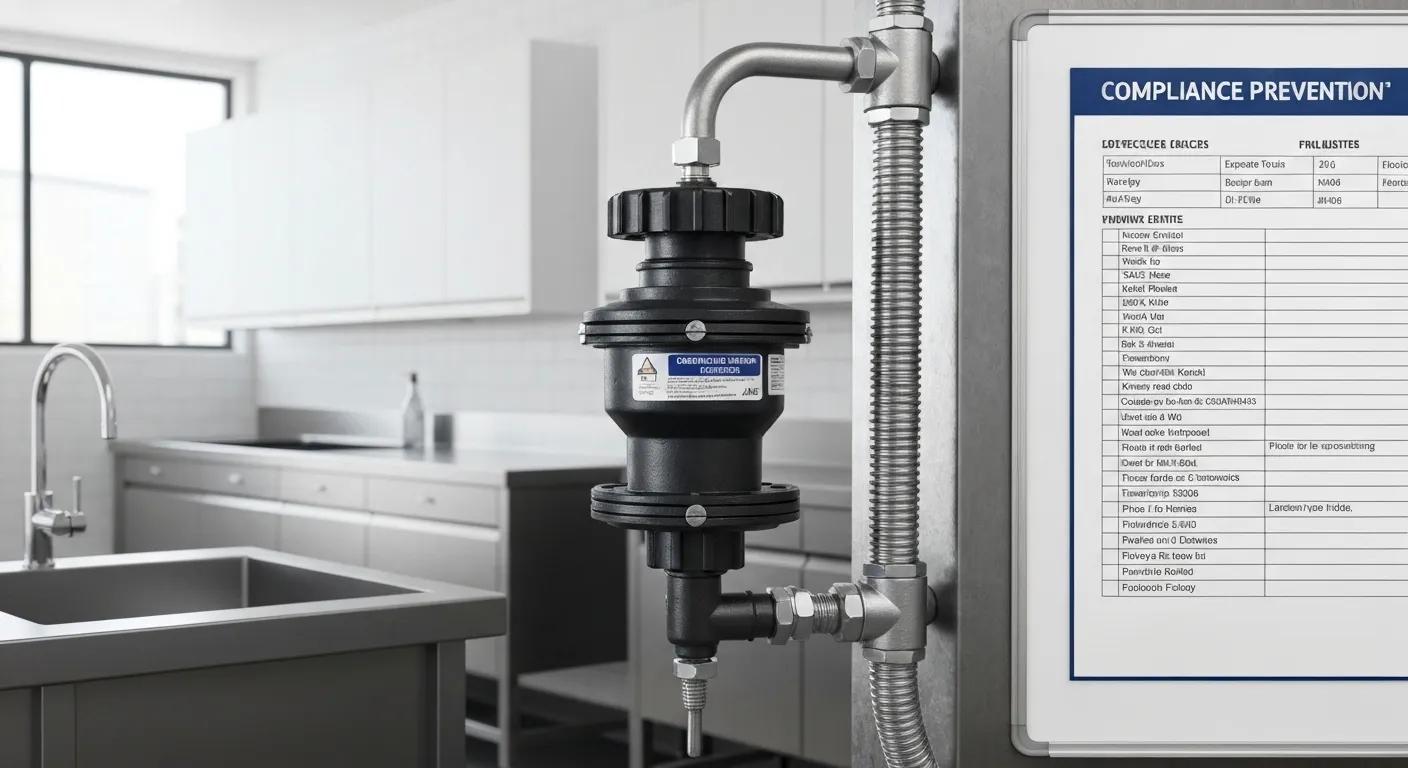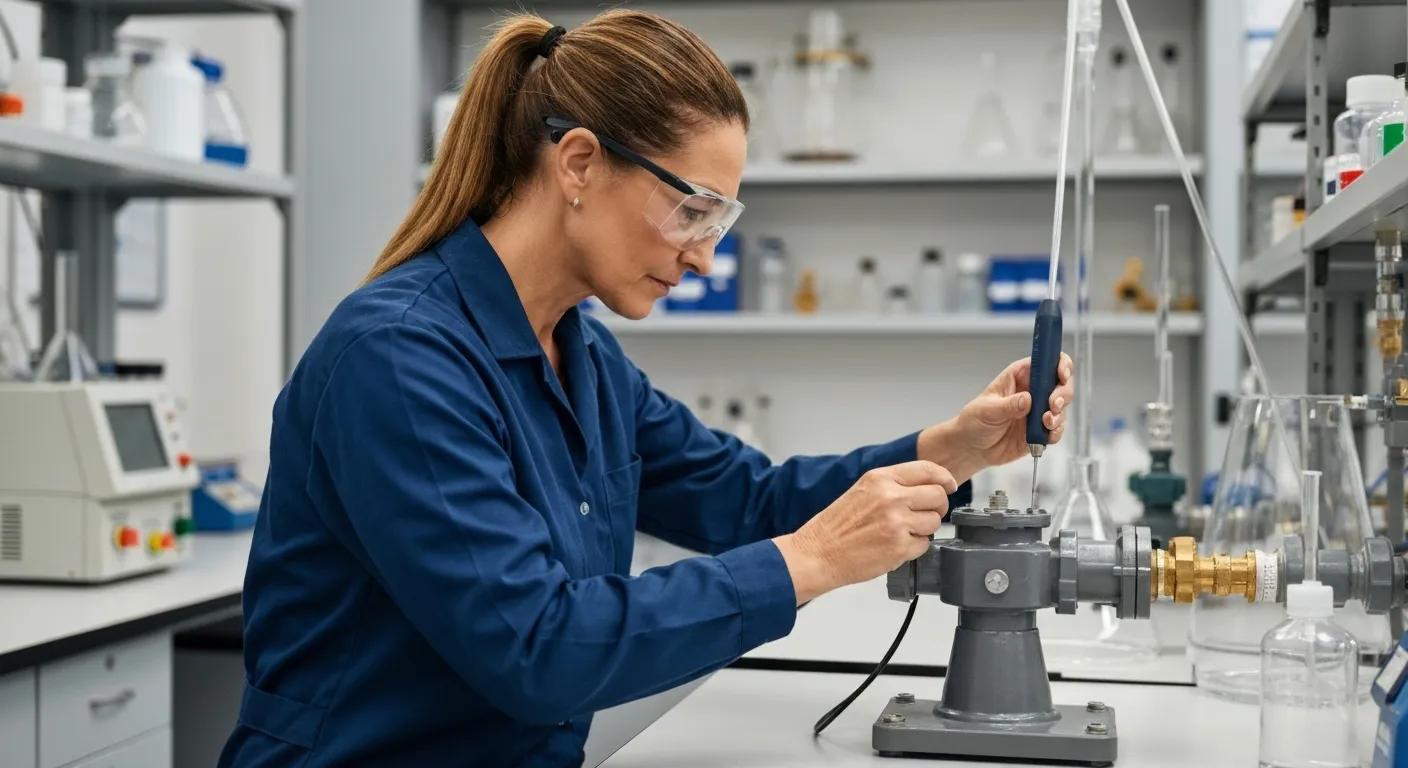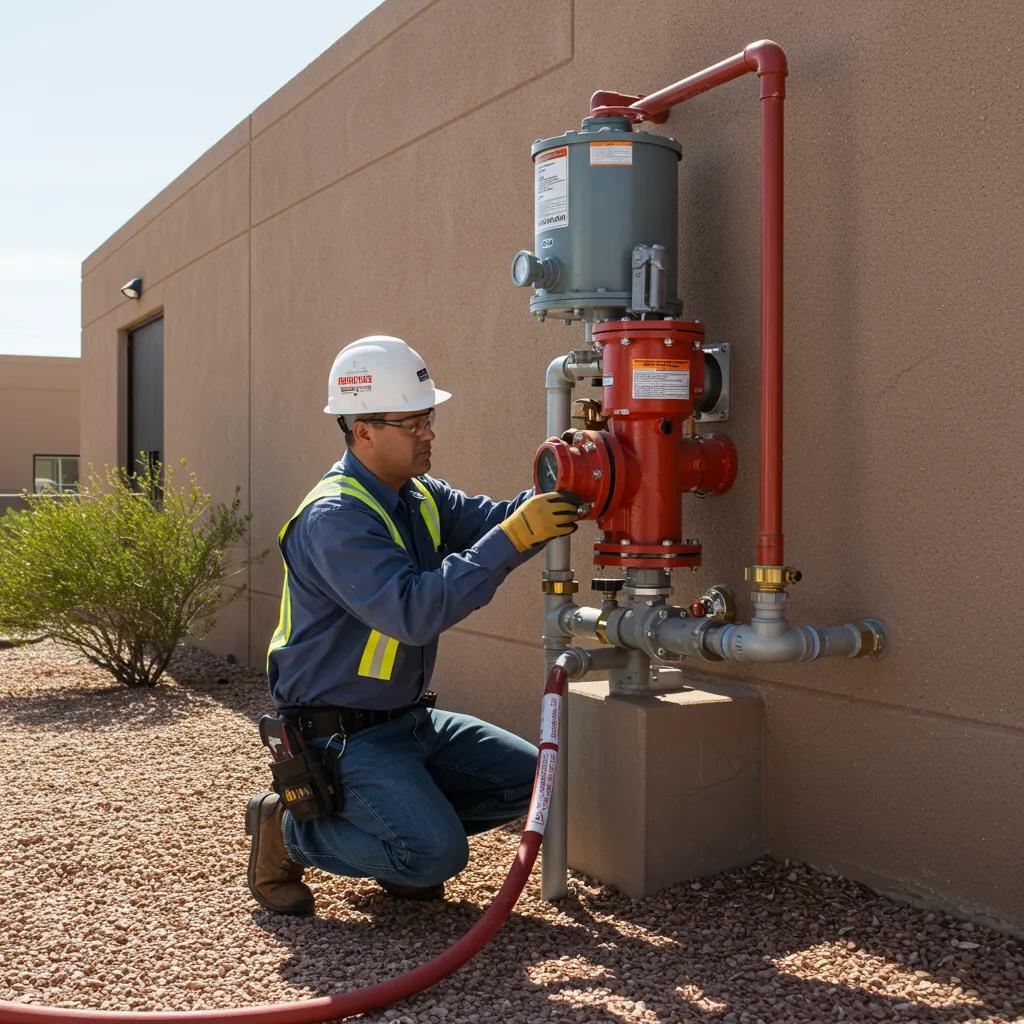Mastering Commercial Backflow Device Installation with Armor Fire Protection: Your Guide to Compliance and Safety
Backflow is the unwelcome reversal of water flow, pushing non-potable water into our clean supply and risking contamination. Understanding the ins and outs of backflow device installation is crucial for safeguarding public health and keeping your water system in top shape. This guide dives deep into the requirements for commercial properties across Arizona, covering everything from official regulations and approved devices to testing, certification, cost factors, and robust cross-connection control strategies. Property owners and contractors, get ready to learn which Arizona and local codes are your must-knows, how to match device types to hazard levels, and what paperwork your municipality expects. We’ll also break down how RPZ, DCVA, and PVB devices work, why certified testers are non-negotiable, and what to expect cost-wise for installation and annual checks. Inside, you’ll find quick decision aids, comparison charts, step-by-step testing guides, and practical maintenance tips to keep you compliant in the Phoenix Metro area. Plus, we’ll point you toward actionable next steps for permits, testing schedules, and finding trusted local experts for inspection, repair, and installation.
What Are the Key Backflow Device Installation Regulations for Commercial Properties in Arizona?

The core installation rules mandate that approved backflow prevention devices must be installed at all commercial cross-connections. You’ll need permits before any work begins, and your installation must be signed off by state or local water authorities to ensure your potable water remains safe. Think of it as a regulatory shield: authorities classify potential hazards, specify the exact devices needed, and require certified installation and testing to guarantee the purity of your water supply. This structured approach minimizes contamination risks and aligns perfectly with guidance from the Arizona Department of Environmental Quality and local water provider ordinances. Grasping these rules helps owners sidestep enforcement actions and ensures your systems sail through municipal inspections.
Which Arizona and Local Codes Govern Backflow Device Installation?
Arizona’s backflow prevention mandates stem from state statutes and official guidance documents. However, your local water authorities and municipal ordinances are where you’ll find the specifics on permitting and approved device types. Local water providers frequently reference the credentials of certified backflow assembly testers and their own cross-connection control programs, while NFPA standards often guide fire system integrations. It’s essential to consult both the ADEQ guidelines and your local water department for their approved device lists, acceptable assemblies, and submission protocols. Confirming local code requirements early in your planning phase can save you significant redesign headaches and permit delays down the road.
What Permits and Documentation Are Required for Installation?
Typically, permit applications require detailed device specifications, site plans illustrating the installation location and necessary access, and manufacturer data sheets, all submitted to your local water authority or building department. Inspectors will be looking for proper shut-off valves, accessible test cocks, adequate clearances, and whether an access box or pit is needed. Overlooking these details is a common reason for delayed approvals. To ensure a smooth review process, your permit checklist should include spec sheets, a cross-connection survey, installer credentials, and proposed testing procedures. Preparing comprehensive documentation upfront will expedite inspection scheduling and secure your municipal sign-off faster.
How Do Hazard Levels Affect Device Selection and Installation Rules?
The level of hazard associated with a cross-connection dictates whether a Reduced Pressure Zone Assembly (RPZ) or a Double Check Valve Assembly (DCVA) is mandated. High-hazard connections almost always require RPZs, while lower-risk situations might permit the use of DCVAs. For instance, chemical storage tanks adjacent to sprinkler lines or systems with potential for additive injection are considered high-hazard. Conversely, simple irrigation-only connections often fall into a lower-hazard category. Your local municipal authorities are responsible for assigning hazard classifications and may impose additional requirements like isolation zones, dedicated vaults, or enhanced monitoring for high-hazard assemblies. A thorough hazard assessment at the outset is key to selecting the correct device and ensuring robust protection for your potable water.
What Types of Backflow Preventers Are Approved for Fire Sprinkler Systems?
For fire protection systems, the commonly approved backflow prevention devices include Reduced Pressure Zone Assemblies (RPZ), Double Check Valve Assemblies (DCVA), and, in certain non-fire potable applications, Pressure Vacuum Breakers (PVB). The specific choice hinges on the assessed hazard level and prevailing local codes. Each device incorporates essential components like check valves, relief valves, and test cocks, all working in concert to prevent any reverse flow from entering potable water systems. Selecting the appropriate assembly not only safeguards public health but also ensures your fire system meets performance standards and gains municipal approval. The following table offers a comparative look at typical device applications and their respective pros and cons for fire systems.
Here’s a breakdown of different backflow assemblies and their typical uses:
This comparison should help clarify device characteristics and inform your system-level decisions when integrating fire protection with potable water safety.
How Does a Reduced Pressure Zone Assembly Work and When Is It Required?
An RPZ operates using two independent check valves. Between them lies a relief zone that automatically vents to the atmosphere if the pressure downstream begins to approach the pressure upstream. This crucial mechanism ensures that contaminated water cannot possibly flow back into the potable supply. This built-in redundancy and the active relief valve function make RPZs the go-to choice for high-hazard cross-connections, especially where chemicals or other pollutants might potentially enter the system. Proper installation demands accessible test cocks, ample clearance, and often an above-grade or easily accessible pit location. Consistent testing and maintenance are vital to keep the relief mechanism functioning optimally and the assembly compliant with local acceptance standards.
What Are the Features and Uses of Double Check Valve Assemblies?
A DCVA employs two check valves arranged in series to prevent backflow. It’s a suitable option for fire sprinkler services classified as low- to moderate-hazard, particularly those that do not involve chemical additives that could contaminate the potable water supply. DCVAs are often favored in retrofit projects where space or budget constraints are a concern, and where local codes permit their use. They are equipped with test cocks for mandatory annual testing and generally require less clearance than RPZs. However, they lack a dedicated relief vent, which means they are not approved for high-hazard applications. The right choice here involves balancing risk assessment, municipal regulations, and your specific system configuration.
How to Choose Between RPZ and DCVA for Fire Protection Systems?
The decision between an RPZ and a DCVA for your fire protection system hinges on a few key factors: the hazard classification of the cross-connection, the specific rules set by your local water authority, and the overall system layout. Your best bet is to consult the relevant codes and conduct a thorough cross-connection survey to guide your choice. Ask yourself critical questions: Are there any additives, antifreeze, or potential chemical exposures involved? What are the anticipated backpressure events? Is there adequate access for testing and maintenance? If local ordinances or ADEQ guidance mandate RPZs for high-hazard situations, your selection becomes a regulatory requirement, not an option. When in doubt, it’s always wise to involve a certified backflow tester or a licensed designer to document your decision-making process for permit applications.
How Often Must Commercial Backflow Devices Be Tested and Certified in Arizona?
In Arizona, commercial backflow devices are generally required to undergo testing on an annual basis. This regular testing is essential to confirm the integrity of the valves and ensure the continued protection of the potable water supply; annual testing is the standard frequency mandated by most municipal programs. Certified backflow assembly testers conduct these tests, which involve controlled valve and relief checks using specialized gauges and the device’s built-in test cocks, to determine if the assembly passes or fails. Prompt testing helps identify any leaks, faulty relief valves, or worn check components before they can lead to contamination. Keeping meticulous testing records and submitting them to your local water authority completes the compliance cycle and prepares you for any audits.
What Is the Role of Certified Backflow Testers in Compliance?
Certified backflow testers possess credentials that are recognized and accepted by local authorities. They perform standardized tests and generate reports that meet municipal requirements, thereby validating your compliance. Their expertise extends to identifying necessary repairs, offering guidance on device selection or relocation, and ensuring that all test data is accurately recorded for submission to the municipality. Engaging a certified tester provides property owners with peace of mind, confirming that their backflow assembly meets all regulatory criteria and minimizing the risk of rejected reports or costly re-inspections. Certification also guarantees that testers adhere to uniform procedures and are knowledgeable about local reporting formats.
What Does the Annual Backflow Testing Process Involve?

The annual testing procedure involves several key steps: first, the backflow assembly is isolated from the system. Then, calibrated gauges are connected to the test cocks to measure differential pressures across each check valve. The relief valve’s function is also tested, and the results for each stage are meticulously recorded as pass or fail. Technicians also conduct a visual inspection of the shut-off valves, test cocks, and the condition of the enclosure, noting any required repairs or parts replacements. If an assembly fails the test, it must be immediately isolated and promptly repaired or replaced before it can be returned to service. Comprehensive documentation is generated during this visit to satisfy municipal reporting mandates and provide owners with essential records.
What Are the Record-Keeping and Reporting Requirements After Testing?
Following the testing, the certified tester is responsible for completing a formal report. This document details the device’s model and serial number, the specific test readings obtained, the pass/fail outcome, and a record of any repairs performed. Many water authorities stipulate a specific timeframe within which these reports must be submitted. Property owners should maintain both digital and hard copies of these records for audit and insurance purposes, adhering to local retention guidelines, which commonly extend for several years. Some municipalities offer electronic reporting options, which can streamline the submission process and reduce paperwork. Consistent and thorough record-keeping is crucial for demonstrating compliance during property transfers or routine inspections.
Armor Fire Protection offers certified backflow testing services throughout the Phoenix Metro area. Property managers can easily schedule their annual testing with our certified technicians to ensure they meet all municipal requirements. Partnering with a local provider guarantees that your tests are conducted by technicians who are intimately familiar with Arizona’s backflow codes and the specific reporting procedures of local water authorities.
What Factors Influence the Cost of Backflow Preventer Installation and Maintenance?
The overall cost for installing and maintaining backflow preventers is influenced by several factors, including the type of device selected, the complexity of the installation, associated permitting fees, site accessibility, and any necessary repairs or parts replacements. These elements collectively shape both the initial project price and the ongoing annual expenses. Different device models, such as RPZs versus DCVAs, come with varying base costs, while retrofitting existing systems or installing devices below grade can significantly increase labor and site preparation expenses. Permit and inspection fees differ by municipality, adding to the upfront investment. Annual testing and occasional repairs represent recurring costs. Understanding these cost drivers allows for better long-term budgeting, focusing on sustained compliance rather than just a one-time purchase.
How Do Device Type and Installation Complexity Affect Pricing?
More advanced devices like RPZs, which offer higher levels of protection, typically carry a higher price tag than DCVAs. They also demand greater clearance and may necessitate pit installations, both of which translate to increased labor hours and material costs. Retrofitting an existing water service often involves reconfiguring piping, coordinating shutdowns, and installing additional isolation valves – all factors that drive up labor time and complicate the permitting process. New installations on a main service line can sometimes be more cost-effective per device compared to intricate retrofits that require structural modifications or close coordination with fire protection contractors. A precise site assessment conducted early on can help prevent unexpected change orders and budget overruns.
What Are Typical Cost Ranges for Commercial Installation and Annual Testing?
While estimated costs for commercial installations can vary widely depending on the specific device and site conditions, you can generally expect a basic DCVA installation to range in the low thousands. More complex RPZ installations, especially those involving vaults and intricate piping, will naturally command higher prices. Annual testing typically represents a more modest, recurring fee that covers the certified tester’s time and the necessary reporting. Prices are subject to fluctuations based on geographic location, the specific model chosen, and whether any repairs or parts are needed during the testing process. When budgeting, it’s wise to include permit fees and an allowance for potential component replacements to avoid any service interruptions.
Here’s a breakdown of common cost components and typical considerations:
This breakdown should help clarify where your budget allocations are most likely to be needed and where proactive planning can help manage costs effectively.
Why Is Professional Installation Important for Long-Term Compliance?
Opting for professional installation by certified technicians ensures that your backflow devices meet all code requirements for clearance, orientation, and accessibility, and that your documentation aligns perfectly with municipal expectations. Correct installation significantly reduces the likelihood of device failure, simplifies the annual testing process, and protects you from potential fines or insurance complications that can arise from non-compliance. Professional installers also provide accurate as-built documentation and can offer expert advice on optimal placement to minimize future maintenance expenses. Investing in certified installation is a critical step in safeguarding potable water safety and ensuring the long-term reliability of your system.
Armor Fire Protection offers comprehensive inspection, repair, and installation services for Backflow Prevention Devices, with a 24-hour response time available throughout the Phoenix Metro area. This ensures local property owners have prompt access to certified installation expertise and competitive quotes for even the most complex projects.
How Does Cross-Connection Control Protect Potable Water in Commercial Settings?
Cross-connection control is the systematic process of identifying, isolating, and protecting points where potable water could potentially mix with non-potable sources. This is achieved through a combination of physical devices, rigorous surveys, and diligent maintenance practices designed to mitigate contamination risks. The strategy is multi-layered: it includes device-based prevention (using RPZs, DCVAs, or PVBs), administrative controls (such as surveys and permits), and operational practices (like clear labeling and staff training). Together, these elements significantly reduce the risk of potable water exposure to hazards. Effective control programs are essential for preserving public health and meeting regulatory obligations, all while enabling the commercial operations that rely on a safe water supply.
What Is Cross-Connection and Why Is It a Risk?
A cross-connection is essentially any physical link that allows potable water to come into contact with a potential source of contamination. Common examples in commercial settings include irrigation systems, boilers, or chemical storage tanks. These connections pose a significant risk because they can facilitate backsiphonage or backpressure events, which can introduce harmful contaminants into the clean water system. In commercial environments, irrigation systems, fire-protection additives, and various industrial processes frequently create cross-connection scenarios that demand careful control. The potential public-health consequences are severe, ranging from microbial contamination to chemical exposure throughout the distribution system – risks that regulatory programs are specifically designed to prevent.
How Do Backflow Prevention Devices Prevent Contamination?
Backflow prevention devices act as mechanical barriers, utilizing components like check valves, relief valves, and test ports to effectively stop reverse water flow caused by backpressure and backsiphonage. This ensures directional safety for potable water supplies. Assemblies like RPZs and DCVAs incorporate redundancy for enhanced fail-safe protection, while PVBs are primarily designed to guard against backsiphonage. Regular testing is crucial to verify that these mechanical elements are functioning correctly and that seals or valves are not compromised by leaks. When used in conjunction with robust administrative controls, these devices form a formidable defense against cross-connection contamination.
What Are Best Practices for Maintaining Cross-Connection Control?
Maintaining effective cross-connection control relies on a consistent approach that includes routine inspections, mandatory annual testing, meticulous inventory and labeling of all backflow assemblies, and comprehensive staff training. This ensures that on-site personnel can readily identify and report potential cross-connections. Recommended practices involve conducting annual cross-connection surveys, maintaining digital records of all tests and repairs, and ensuring that backflow assemblies are clearly accessible and properly signed for ease of testing. Integrating certified testing, prompt repairs, and a structured survey schedule provides continuous protection and supports compliance during municipal audits.
Armor Fire Protection proudly serves Gilbert and the wider Phoenix Metro area, offering expert certified backflow testing and backflow prevention device installation services. Property managers looking for quotes, compliance audits, or certified annual testing can easily connect with a local provider to arrange for service and scheduling.



